-
current
recommendations- Liefdefjord
New page dedicated to one of Spitsbergen's most beautiful fjords. Background information and many photos.
- New Spitsbergen guidebook
The new edition of my Spitsbergen guidebook is out and available now!
- Liefdefjord
New page dedicated to one of Spitsbergen's most beautiful fjords. Background information and many photos.
Page Structure
-
Spitsbergen-News
- Select Month
- June 2025
- May 2025
- April 2025
- March 2025
- February 2025
- January 2025
- December 2024
- November 2024
- October 2024
- September 2024
- August 2024
- July 2024
- June 2024
- May 2024
- April 2024
- March 2024
- February 2024
- January 2024
- December 2023
- November 2023
- October 2023
- September 2023
- August 2023
- July 2023
- June 2023
- May 2023
- April 2023
- March 2023
- February 2023
- January 2023
- December 2022
- November 2022
- October 2022
- September 2022
- August 2022
- July 2022
- June 2022
- May 2022
- April 2022
- March 2022
- February 2022
- January 2022
- December 2021
- November 2021
- October 2021
- September 2021
- August 2021
- July 2021
- June 2021
- May 2021
- April 2021
- March 2021
- February 2021
- January 2021
- December 2020
- November 2020
- October 2020
- September 2020
- August 2020
- July 2020
- June 2020
- May 2020
- April 2020
- March 2020
- February 2020
- January 2020
- December 2019
- November 2019
- October 2019
- September 2019
- August 2019
- July 2019
- June 2019
- May 2019
- April 2019
- March 2019
- February 2019
- January 2019
- December 2018
- November 2018
- October 2018
- September 2018
- August 2018
- July 2018
- June 2018
- May 2018
- April 2018
- March 2018
- February 2018
- January 2018
- December 2017
- November 2017
- October 2017
- September 2017
- August 2017
- July 2017
- June 2017
- May 2017
- April 2017
- March 2017
- February 2017
- January 2017
- December 2016
- November 2016
- October 2016
- September 2016
- August 2016
- July 2016
- June 2016
- May 2016
- April 2016
- March 2016
- February 2016
- January 2016
- December 2015
- November 2015
- October 2015
- September 2015
- August 2015
- July 2015
- June 2015
- May 2015
- April 2015
- March 2015
- February 2015
- January 2015
- December 2014
- November 2014
- October 2014
- September 2014
- August 2014
- July 2014
- June 2014
- May 2014
- April 2014
- March 2014
- February 2014
- January 2014
- December 2013
- November 2013
- October 2013
- September 2013
- August 2013
- July 2013
- June 2013
- May 2013
- April 2013
- March 2013
- February 2013
- January 2013
- December 2012
- November 2012
- October 2012
- September 2012
- August 2012
- July 2012
- June 2012
- May 2012
- April 2012
- March 2012
- February 2012
- January 2012
- December 2011
- November 2011
- October 2011
- September 2011
- August 2011
- May 2011
- April 2011
- March 2011
- February 2011
- January 2011
- December 2010
- November 2010
- September 2010
- August 2010
- July 2010
- June 2010
- May 2010
- April 2010
- March 2010
- February 2010
- November 2009
- October 2009
- August 2009
- July 2009
- June 2009
- May 2009
- April 2009
- March 2009
- February 2009
- January 2009
- December 2008
- November 2008
- October 2008
- August 2008
- July 2008
- June 2008
- May 2008
- April 2008
- March 2008
- February 2008
- April 2000
- Select Month
-
weather information
-
Newsletter

| Guidebook: Spitsbergen-Svalbard |
Home
→ June, 2020
Monthly Archives: June 2020 − News & Stories
Corona: Arctica II in August cancelled
It is not a good year for tourism and this will probably not really change at any time soon, especially when it comes to the combination of small ships and remote areas. Even though ship-based tourism is now, in theory, possible again in Spitsbergen under strict conditions and Norway is about to open borders again for European tourists, the conditions are strict and make if very difficult, or actually pretty much impossible, to start sailing again especially with small ships.
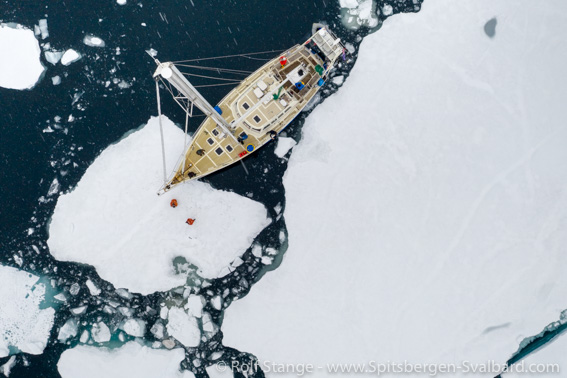
With Arctica II in drift ice near Spitsbergen: we would have loved to do that in August. But it won’t happen because of the Corona crisis.
So, long story, short message: now we are sadly forced to cancel also our trip with the sailing boat Arctica II in August because of Corona. All participants will asap be contacted by the Geographische Reisegesellschaft.
Norway opens for tourists from 15 July
Norway wants to open borders for tourists from Europe (Schengen area/European Economic Area) outside Scandinavia from 15 July. In a press release, the Norwegian government explains that there will still be restrictions: The Norwegian Folkehelseinstitutt (authoritiy for public health) will monitor the Corona development in relevant countries and regions. Tourists from areas with SARS-Coronavirus-2 (“Corona”) infections above a certain threshold will have to stay in quarantine for 10 days in Norway. Tourists who need to stay in quarantine and who want to travel to Spitsbergen have to to their quarantine on the Norwewian mainland and can only travel further on to Spitsbergen when they have done their time.
Also tourists from countries who do not monitor the development appropriately or who do not publish relevant data will have to expect such restrictions.
The Folkehelseinstitutt publishes a map that shows countries in green or red. Tourists from countries shown in green will be able to enter Norway without quarantine from 15 July (earlier for Scandinavian tourists). Currently, the map shows only Scandinavia. An updated version including all European countries that are part of the Schengen area or European Economic Area is expected for 10 July. It will be updated at least every 14 days.
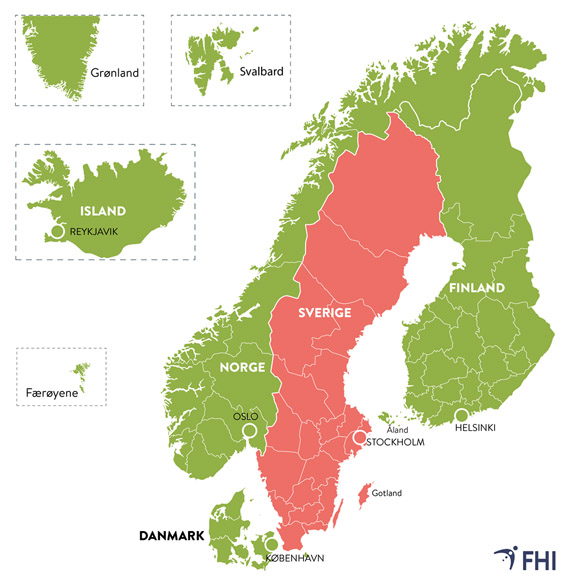
Map of the Folkehelseinstitutt: tourists from green countries may enter Norway without quarantine. Currently only Scandinavia is shown, Europe will follow on 10 July.
Currently, only people with special reasons such as close family relationships, work or property may enter Norway under certain regulations (unless you are Scandinavian but not Swedish).
Lethal anaesthetisation of polar bear criticised by authorities
A polar bear was anaesthetised and flown out from the Longyearbyen area by the Sysselmannen earlier this year, on 30 Januar. The bear, a young female of only 62 kg, died during the flight. Shock caused by physical stress in combination with the anaesthetisation was later identified as the cause of death. The bear had been chased away from Longyearbyen by helicopter for more than two hours before it was put into deep sleep.
Now the case was criticised by Mattilsynet, the Norwegian authority for food safety, which is also responsible for animal welfare including anaesthetisation (immobilisation by means of medication) of wild animals, as Svalbardposten describes with a long article. This is something that happens often in Spitsbergen, mostly in connection with research, sometimes also when the police (Sysselmannen) handles polar bear near Longyearbyen. The Norwegian animal welfare law is also in force in Spitsbergen, but not so the animal health personell law (Dyrehelsepersonelloven). The application of its main principles is, however, demanded by the animal welfare law.
Mattilsynet has found several points of criticism, also mentioning a lack of competence. One point of general criticism is the lack of knowledge-based routines for catching (anaesthetising) polar bears; something that representatives of the Norwegian Polar Institute, which is managing the anaesthetisation, do not agree with. Both the Norwegian Polar Institute, represented by polar bear researcher Jon Aars (who was not involved in the operation on 30 January) and the Sysselmannen, represented by environmental officer Morten Wedege, have replied to the criticism in Svalbardposten.
Another point of criticism is the lack of consideration of the physical parameters of this particular bear before the anaesthetisation. Is is in the nature of the process that a polar bear can not be weighed before anaesthetisation. The one that died in the given case weighed only 62 kg and it appears likely that this may have contributed to the lethal outcome. Additionally, there was no veterinary-medical emergency equipment available and no associated competence to handle any emergency that might occur under anaesthetisation. According to the reply to the criticism by the Norwegian Polar Institute, this should, based on experience from thousands of anaesthetisations of polar bears, not have necessary. But scientific anaesthetisations under much more controlled circumstances, in daylight, with smaller helicopters and as a matter of choice in each individual case, so one may ask if this kind of experience is a good basis for decisionmaking in a case like the one given here.
But this is, as far as known, not further considered by Mattilsynet. Responsible region leader in north Norway Hilde Haug emphasizes that it is their main concern to make sure that such cases do not happen again by improving relevant routines. In case of future recurrence, Haug does not want to exclude use of legally binding steps.

Young polar bear together with its mother. The little bear was about 20 months old at the time the picture was taken and its weight was likely well above 60 kg.
In the Svalbardposten article, two veterinarians give some interesting insight. It is these two who come into question as vets who have prescribed the medication that was used to anaesthetise („immobilize“) the bear on 30 January. But this did not happen in connection with the given case: because of the regular use of the drug, mostly in connection with research and occasionally in the context of police operations, the Norwegian Polar Institute has a stock in Longyearbyen. In principle, the prescribing veterinarian remains responsible for the use of the drug in each case, but he/she is usually in practice not involved. Legally, a vet can let a helper handle the actual use of the drug if responsible. But none of the two vets was contacted in connection with the operation on 30 January, and one of them states that he would have denied use of a drug prescribed by him in this case.
It is, however, uncertain who of the two actually prescribed the batch that was used then. Both assume that it was not from their respective prescription.
It should also be noticed that shooting the bear directly would have been a likely alternative, from the perspective of the Sysselmannen.
It is another aspect that the actual medication may have been out of date, but this is unlikely, according to the Norwegian Polar Institute, and unlikely to have made a difference, had it indeed been the case.
In the press releases during and after the incident, the Sysselmannen emphasized repeatedly the presence and direct involvement of „polar-bear professional specialist competence“ provided by the Norwegian Polar Institute in the operation. No names or professions are given, but veterinarians are usually not directly involved. Both veterinarians who prescribed the drug expressed that they would have appreciated to be contacted, but this did not happen. Even if it may be impossible to fly a vet up to Longyearbyen from Tromsø or elsewhere in mainland Norway in time for such an operation, advise by telephone could have made a difference.
Everybody involved knows the legal and practical complexity of such a situation and the difficulty of making decisions under time pressure and in a situation of stress. But it appears fair to conclude: anaesthetising a large animal such as a polar bear just after having exposed it to great physical stress over more than 2 hours, without knowing its weight and physical condition and without having veterinary-medical emergency equipment and a veterinarian available – that is not exactly what many will consider responsible handling of a strictly protected animal.
Government re-opens Spitsbergen for cruise ships
Re-opening Spitsbergen for land-based tourism is a process that has already begun. Since 01 June, visitors from mainland Norway can travel to Spitsbergen again, other Scandinavian countries (except Sweden) will follow soon, on 15 June.
At the same time it has, so far, been mentioned that “coastal cruises” over several days would take some more time because of their specific challenges. First steps have now been taken to re-open for this kind of travelling: according to a press release by the Norwegian ministry of justice, which is responsible for Spitsbergen, ships may start cruising Spitsbergen again now under several conditions. Only ships with a maximum capacity of 500 passengers are permitted and they may only use 50 % of their capacity. The theoretical maximum number of passengers on board is thus limited to 250. Only passengers from countries whose inhabitants can travel freely to Norway including Spitsbergen are allowed: this is currently mainland Norway and soon also Denmark, Finland and Iceland.
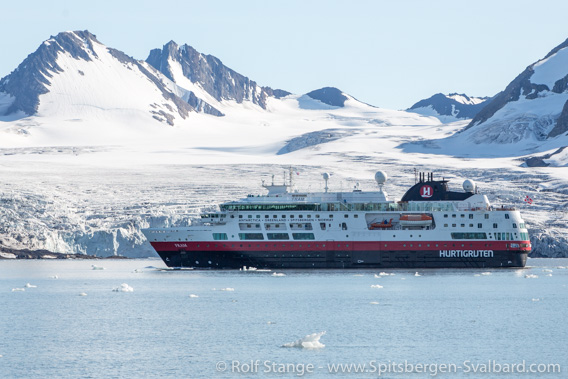
“Coastal cruises” in Spitsbergen: now possible again – under certain conditions.
As all tour operators who are running land-based tourism, a hygiene and health safety plan needs to be prepared and approved by the authorities for every ship, based on general Corona safety guidelines which have been prepared by Svalbard Reiseliv, a local tourism organisation, together with relevant authorities. It remains to be seen which ships will be able to meet the requirements in terms of minimum distances etc.
Ships have to be prepared to sail directly to Tromsø in case of a suspected Covid-19 infection on board, rather than to Longyearbyen.
Passengers from countries other than the above-mentioned Scandinavian ones will need some more patience. The Norwegian government has announced to come with information regarding a possible re-opening of Spitsbergen for citizens and residents from “neighbouring” European countries until 20 July.
Ship-owners and tour operators will have to see if they can actually operate with a maximum capacity of 50 %.
Polar bear shot on Phippsøya in 2018: no report yet
The case of the polar bear that was shot in late July 2018 on the island of Phippsøya by a crew member of the German cruiseship Bremen attracted media and public attention around the world.
A team from the ship had gone ashore on Phippøya, which belongs to Sjuøyane in northernmost Svalbard, to check the site before passengers were scheduled to come ashore. The dramatic incident ended with one person receiving minor head injuries and the bear being shot. Passengers were not ashore during the incident.
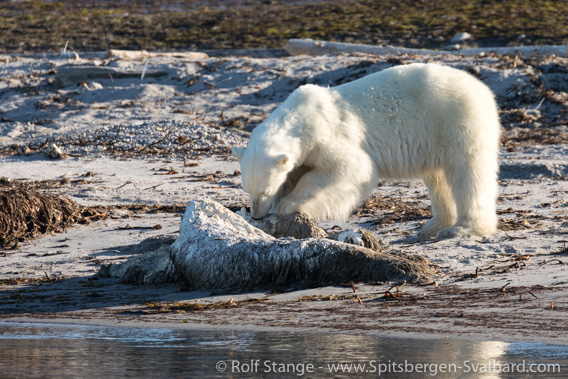
Polar bear on Phippsøya, a common landing site, in mid July 2018. It was very likely this bear that was shot in the same place in late July.
Almost two years have gone past now and one may wonder what came out of the whole thing. The disappointing intermediate result is that there is no result yet, as Svalbardposten was told on request by the Sysselmannen. The case was originally handled by the Sysselmannen and then it went to relevant authorities in mainland Norway for further legal treatment and from there in late 2019 back to the Sysselmannen. And there it still is today. The large capacities absorbed by the Corona crisis are said to have played a role in recent months.
So while we still have to wait for confirmed information, we can speculate a bit about some factors that may have contributed to the tragic outcome: It is certainly possible to not see a polar bear that is in the vicinity in the uneven terrain of that particular place on Phippsøya even if one is alert. There was a carcass on the beach at that time, and the bear had been returning to that carcass repeatedly over a longer period to feed on it. The carcass was lying in the area where landings are commonly made, but it was hard to see from the distance.
If one happens to go ashore close to the carcass, then it is certainly possible that a bear that is in the area, resting and waiting for the appetite to return, shows a rapid and aggressive reaction.
Again: this is speculation, based on local knowledge and experience, including a sighting of a polar bear in this given place in mid-July 2018, which was most likely that particular bear that was shot soon thereafter. Meanwhile, we can curiously await the report from the Norwegian authorities to learn more about what actually happened during the incident.
Avalanche accident on Fridtjovbreen in February: first report
A first report has been published that sheds some light on the tragic avalanche accident that happened on 20 February on Fridtjovbreen. The report is written by a group of people from the Arctic Safety Centre at UNIS, the avalanche group of the local Red Cross and local avalanche observers of the Norwegian avalanche warning system, varsom.no; it was published on varsom.no. It is not a report by the Sysselmannen or other legal or governmental authority and it does not include a legal assessment. The point of the report is to understand the accident and to draw conclusions to improve safety out in the field.
On 20 February, a group of 7, including two guides from the Russian Arctic Travel Company Grumant, left Barentsburg, heading for the glacier front of Fridtjovbreen, south of Barentsburg in Van Mijenfjord. The group made a stop at the southeastern slope of Marcussenfjellet on the higher part of Fridtovbreen to visit a meltwater cave. The cave is very close to the steep slope of Marcussenfjellet and a terrain depression between the cave and the mountain was used to park the snow mobiles. The first three snow mobiles had already stopped when the avalanche went down. Two persons were completely covered by the snow masses and two others partly. The three remaining persons were not caught by the avalanche.
The volume of the avalanche is estimated to have been near 10,000 cubic metres, the collapsed snow area on the slope was 13,000 square metres.
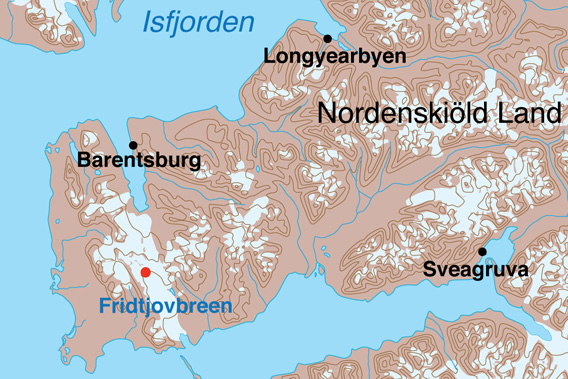
The approximate accident site is marked with the red dot.
Map base © Norwegian Polar Institute.
Modified by landkarten-erstellung.de and this author.
The two persons who were completely under snow died. According to an official press release (Sysselmannen), the two victims were Sascha Brandt (39) and Magdalena Katarina Zakrzewski (40), both from Germany.
One of the two victims was covered by half a metre of snow. This person was dug out after 20 minutes. The other one was under two metres of snow. In this case, it took one hour. The guides and other group members used avalanche probes and snow shovels to recover the victims.
The group did not have any avalanche transceivers/avalanche beacons.
Alarming the rescue forces took time because the satellite phone that the group was equipped with was on one of the snow mobiles that were covered with snow (there is no mobile phone coverage in this area). Finally, the second guide could use an InReach to send a message to Barentsburg, from where the Sysselmannen in Longyearbyen was informed. The rescue helicopter could not land on location due to poor weather. It took two hours from the emergency call and until the rescue forces arrived. The doctor who came as part of the rescue team could only declare the two victims dead.
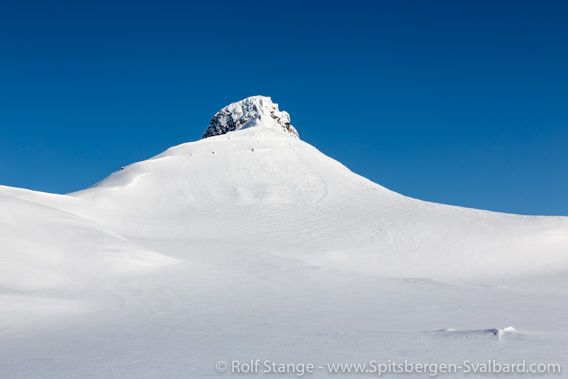
Beautiful, but also dangerous: mountain slope at Fridtjovbreen
Snowfall, wind and fluctuating temperatures during the weeks before the accident had contributed to the general avalanche risk: several layers of firn with poor bonding capabilities were under a layer of fresh, wind-blown snow. The Norwegian avalanche warning service (varsom.no, link above) had issued a level 2 warning (moderate risk; the highest level is 4).
One of the conclusions of the reports is that the presence of the group, with the impact of the snow mobiles on the snow, had triggered the avalanche.
As general recommendations, the report points out that all members of a snow mobile group should have avalanche equipment (specifically avalanche transceivers/beacons, snow shovel, avalanche probe) and everybody should be trained in the use of the equipment. Ideally, this should also be the case for tours in easy, open terrain, where avalanche-prone slopes can be kept at a safe distance, according to the report. But it is especially important for tours in complex terrain, closer to avalanche-prone slopes. The terrain of the tour from Barentsburg to the front of Fridtjovbreen is generally easy and in open terrain, but things are different for the deviation from the common route to the ice cave close to Marcussenfjellet.
As mentioned: the report in question is an evaluation of the incident by avalanche experts with local knowledge and not a legal assessment. This will be made by Norwegian authorities and it is currently still in process and not yet published.
Spitsbergen with Antigua in July cancelled
It is really not a surprise, but now it is official: our Spitsbergen voyage with Antigua in July is cancelled for reasons that will hardly require an explanation. The participants who are booked on this voyage will be contacted soonest by the Geographischen Reisegesellschaft.
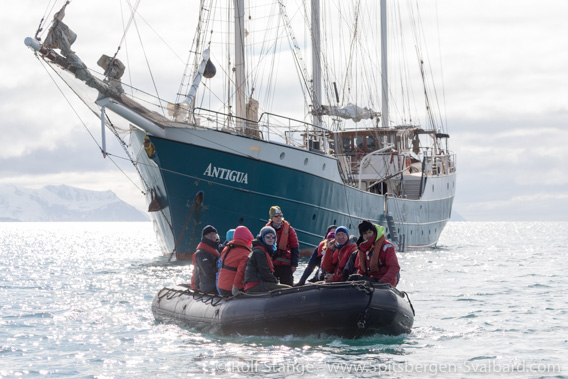
With Antigua in Spitsbergen: won’t happen in July 2020.
I have to admit that this is a bit emotional. The thought of all the arctic soulfood that is lost this year can bring more than just a bit of water to one’s eyes. Certainly to mine, at least. This summers’ first, early season trip in Spitsbergen on Antigua would be happening right now. Still a lot of snow and ice up north. But in real life, Antigua is about as far away from Spitsbergen as most of you readers will be. A few weeks ago, on the trip up from mainland Norway to Spitsbergen, we might have seen Bear Island as we haven’t seen it at all in recent years: with dense ice packed all round the shores! We can only imagine how good that might have been. Sad. I am sure that I can honestly think and write that on behalf of all passengers and crew.
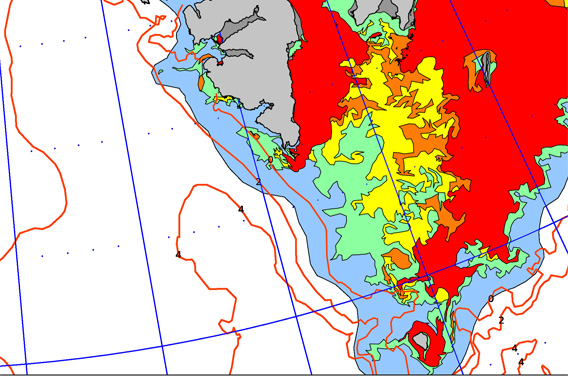
Ice chart of south Spitsbergen, early May: ice around the south cape, Bear Island and on the east coast, Bellsund frozen solid. How good would that have been …
Ice chart © Norwegian Meteorological Institute.
Beyond all the good experience that is now lost, you may imagine that this is also a bit of a tough blow economically. In this context, I may mention that my Spitsbergen online shop has never been closed and it will remain open and accessible at any time and you can find a lot of good stuff there to travel the Arctic without leaving the sofa! Next to the famous Spitsbergen bible, there is the less famous, but maybe even more beautiful photo book with the aerial photos or, with the driftwood picture frames and the kitchen slats, a real piece of Spitsbergen on the wall or the kitchen table, respectively, to mention just a few.
Generally, tourism is starting up slowly again in Spitsbergen. Emphasize “slowly”. But this, again, will hardly come as a surprise: so far, only tourists from mainland Norway can visit Spitsbergen. Danish tourists will be the next ones who will be allowed in from 15 June. The Norwegian government has announced to make a statement regarding visitors from “near-by European countries” until 20 July. So, stay tuned.
Anyway, ship-based travelling over several days is so far excluded and it is announced that it will take “more time” (without further specification) until this kind of travelling can take place again.
News-Listing live generated at 2025/June/15 at 07:14:17 Uhr (GMT+1)




























